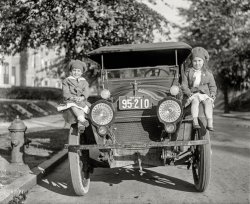
MAY CONTAIN NUTS

Search Shorpy
SHORPY ART

Framed or unframed, desk size to sofa size, printed by us in Arizona and Alabama since 2007. Explore now.
Join and Share
Ad-Free Shorpy
Shorpy is funded by you. Patreon contributors get an ad-free experience.
Learn more.

Recent comments
- Details, Details
- What's that building to the left of the tower?
- Coal Barges
- Bromo-Seltzer
- Inner harbor
- The Basin
- What a headache!
- Giant stepladder?
- Baldwin 62303
- Baldwin VO-1000
- Cold
- No expense spared
- Tough Guys
- Lost in Toyland
- And without gloves
- If I were a blindfolded time traveler
- Smoke Consumer Also Cooks
- Oh that stove!
- Possibly still there?
- What?!?
- $100 Reward
- Freeze Frame
- Texas Flyer wanted
- Just a Year Too Soon
- WWII -- Replacing men with women at the railroad crossing.
- Yes, Icing
- You kids drive me nuts!
- NOT An Easy Job
- I wonder
- Just add window boxes
Member Photos
The Shorpy
Print Emporium
Print Emporium
Search Shorpy
Search results -- 30 results per page
- Boys on a Buick: 1960
- ... Must have been in inventory.
Car Model Years New cars are introduced in the fall of the year, so the 1942 models were in ... Posted by Mvsman - 10/11/2012 - 6:11pm -
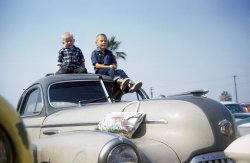
- Old Cold: 1905
- ... to this photo; the snow, the pedestrians, the lack of cars or driveways, the order represented by the gridlike planting of the trees ... Posted by Dave - 07/29/2012 - 6:11pm -
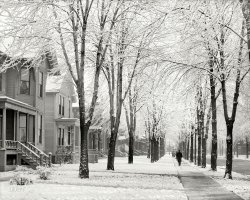
- Route 1: 1940
- ... windows into their basements.
(The Gallery, Baltimore, Cars, Trucks, Buses, Gas Stations, Jack Delano) ... Posted by Dave - 03/29/2019 - 7:09pm -
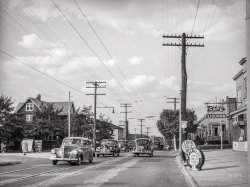
- What a Dump: 1941
- ... Dump Truck and the Blaw Knox Bulldozer!
(The Gallery, Cars, Trucks, Buses, John Vachon, Mining) ... Posted by Dave - 03/24/2020 - 12:32am -
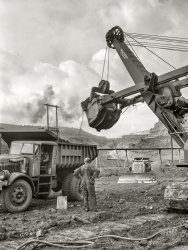
- Everybody Go to the Ball Game: 1923
- ... boy on the far right. He's so jaunty!
(The Gallery, Cars, Trucks, Buses, Kids, Natl Photo, Sports) ... Posted by Dave - 08/31/2012 - 8:18pm -
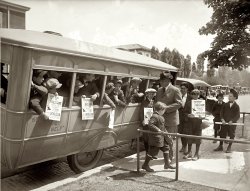
- Group Chat: 1941
- ... but the Coke sign is long gone.
(The Gallery, Cars, Trucks, Buses, Jack Delano, Small Towns) ... Posted by Dave - 11/11/2018 - 2:54pm -
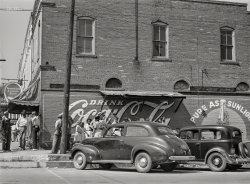
- Railyard Rollers: 1905
- ... when I saw this detail.
Never thought abut how rail cars wereloaded by hand before. The sunken rails, two men on a barrel, wooden ... Posted by Dave - 08/08/2012 - 2:50pm -
![Railyard Rollers: 1905 Gulfport, Mississippi, circa 1905. "New Orleans supply yard, Union Naval Stores. Shipment of rosin and turpentine." 8x10 inch glass negative. View full size.
Can't get enough turpentine photos!The gum naval stores industry as practiced before WWII is now mostly forgotten, but was once a Really Big Deal in the longleaf pine belt that stretched from North Carolina to the Gulf coast of Texas. Sadly, most of the longleaf pines are gone now, and several species dependent on the pine forests-- for instance, the ivory-billed woodpecker-- are gone for good.
Those barrels would have been made and filled with turpentine and rosin distilled in small batches at camps located way out in the piney woods, by men working under absolutely medieval conditions. The ones working to pay the company store were lucky compared to the ones who were convicts leased from local law enforcement.
I've seen most of the more widely available turpentining images, but this is a new one on me-- thanks for running it, Dave.
LunchtimeThere appears to be a lovely young lady bringing some lucky gentleman his lunch bucket, and much prestige from his comrades.
Hard labourfor those guys. It looks hot after maybe some recent rain, the barrels sure look heavy and there's a few hours left yet. Looks like there's refreshments being bought over by the youngster on the right.
Thanks for the info Thad, I never knew about turpentine's origin such as shown above.
Even the Lionel Lines1950s model barrel loader was more mechanized than this.
WWWaaa - ter boo-ooyyyBring the buck-buck-bucket here!
I remember that song so well, I could hear it in my mind when I saw this detail.
Never thought abut how rail cars wereloaded by hand before. The sunken rails, two men on a barrel, wooden rails to roll them on, all fascinating!
Safety firstThe bridges over the rail trench are noticeably lacking proper railings. 1 safety demerit!
Good, I'm starved.Here comes lunch!
As far as the eye can seeJust how many hundreds of thousands of barrels of rosin and turpentine could possibly be needed? And for what purpose, painting?
[Used in the manufacture of soap, paper, paint and varnish. More on the "naval stores" industry, and the origin of the term. - Dave]
Turpentine Forests
Washington Post, Sep 15, 1902.
Turpentine Forests.
Their Rapid Destruction Threatens the Ruin of a Great Industry.
From the New York Commercial.
The first organization of turpentine men, known as the Turpentine Operators and Factors' Association, which recently held its first annual convention in Jacksonville, Fla., was confronted by the question of complete annihilation of their business, due to the ruthless tapping of young trees and the rapid depletion of the pine forests. Ten years ago Norfolk, Va., was the great naval stores port of the United States, five years ago Charleston was the center of the industry, two years ago Savannah, and now Jacksonville, and next Tampa and then — what? Prof. Herty, of the United States Department of Forestry, has been called upon and was present at the convention.
Newspapers in the South have presented able articles on this same subject for years, but the writer has seen young trees no thicker in diameter than eight inches boxed; once, twice, yes three times, so that a step ladder was used for the top boxing and the strip of bark left was insufficient to gather the sap to feed the tree. The life of a turpentine tree after the first boxing is about two years. That means that after the sap has been taken the third time the tree must either be cut for timber or it dies. A trip through the pine forests of Georgia and Florida will demonstrate the reckless manner in which the boxing has been done, and, worse still, where clearings have been made, no effort has been made to check the growth of scrub oak and saw palmetto which effectually choke the young pine rearing its head where its parent stood. Gradually the operators have been driven south, and to-day it is estimated that at least one hundred camps are located in Florida alone, and about fifty camps in Georgia.
Nine hundred operators were at the convention. Each man has either bought or covered with options more or less pine forest, and in spite of his knowledge of what the future will bring is rapidly killing the goose with the golden egg. The end is near in the turpentine and rosin industry. A few more years will see a tremendous rise in these commodities, and no effort has yet been made to restore the depleted forests of Virginia, Georgia, Alabama, North Caroline, or Northwestern Florida. The "fat pine" is indigenous to these States, it grows rapidly, but is easily exterminated by the more sturdy plants which spring up in the forest clearings.
(The Gallery, Boats & Bridges, DPC, Railroads)](https://www.shorpy.com/files/images/4a17950a.thumbnail.jpg)
- Hatchlings: 1942
- ... International way up north of town. GM kept building cars there until 1987, and tore down the plant in 1989. The airport was in ... Posted by Dave - 04/17/2014 - 10:36am -
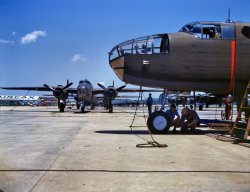
- A Merry Young Soul: 1917
- ... are about 60 Coles left in existence.
(The Gallery, Cars, Trucks, Buses, Chris Helin, San Francisco) ... Posted by Dave - 06/02/2016 - 7:50pm -
![A Merry Young Soul: 1917 San Francisco circa 1917. "Cole Eight Toursedan at Golden Gate Park." Latest epistle in the Shorpy Bible of Brobdingnagian Broughams. View full size.
Shadows and FDRI'm surprised the photographer's shadow is so prominent. Guess I presume that professional photographers are more diligent about aspects like that - distracting things in foreground, etc. I'm guessing this shot wasn't used for any published purpose.
[Would be easily dealt with in preparing the photo for newspaper publication, as was the intent. Lighting, background and composition were more important factors for the shoot itself. -tterrace]
Living FossilA friend of mine here in the Detroit area has what is an exceedingly rare auto, a 1915 Cole 4-40 touring car, which might be the only one left in the world. That is the original color - not every early car was black.
Always wanted to put a bumper sticker on it "Powered By COLE."
Cole 8The Cole was a high quality auto made in Indianapolis. Before WWI there were only a few autos that had the unusual V8 engine. There were earlier V8s but it was Cadillac that developed in great secrecy and "revealed" the American V8 in 1914 (a little later used in Oldsmobiles and Chevrolets.
In '24 a Cole was the Indy 500 pace car but that was getting close to the end of the Cole company's life. There are about 60 Coles left in existence.
(The Gallery, Cars, Trucks, Buses, Chris Helin, San Francisco)](https://www.shorpy.com/files/images/SHORPY-978.thumbnail.jpg)
- Antique Excavation: 1917
- ... to flip over backwards on the operator.
(The Gallery, Cars, Trucks, Buses, D.C., Natl Photo) ... Posted by Dave - 11/12/2013 - 8:48am -
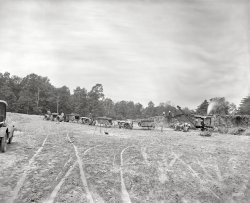
- Crunch Time: 1923
- ... of returning to dodge trams on M Street.
(The Gallery, Cars, Trucks, Buses, D.C., Harris + Ewing) ... Posted by Dave - 07/10/2013 - 10:37am -
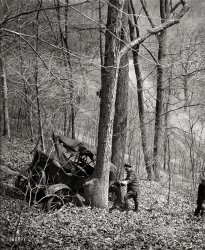
- Peerless in the Pines: 1923
- ...
(The Gallery, Cars, Trucks, Buses, Chris Helin) ... Posted by Dave - 06/16/2016 - 2:26pm -
![Peerless in the Pines: 1923 Circa 1923. "Peerless touring car at Lake Tahoe (California)." Rolling on Kelly Balloons. 5x7 glass negative by Christopher Helin. View full size.
GASOLINEIt's a gas can. It even says "GASOLINE," stenciled on the side! The running-board mounted frame secures it all around and over the top. Also common in those days was a trio arrangement of smaller cans in a similar carrier for gas, oil, and water.
Peerless was an upscale make, but those hood latches are a type that shakes loose pretty easy, thus the rope through all four latches, to keep them fastened.
I believe but cannot say for certain that those fitted windows were factory accessories. Again, not an economy car.
At first I thought Mr. Backseat was lighting a cigarette, but now I'm leaning toward the snack.
Calling all Shorpy experts...What is on the driver's side running board? And what is the rope or cord on the hood holding up on the passenger side? Are the windows aftermarket?
Not an expertBut I think that might be a tool case on the running board. I'm wondering if the occupants have some kind of card game going on.
[Looks to me like they're having a snack. -tterrace] Looking again dang it. I think you're right tterrace. My 500th comment since joining Shorpy was not my best.
No expert, but --1) Tools, perhaps?
2) That strap is crossed over on top, and looks like it's holding the hood latches up. I could see how they might loosen on rough roads, and this car looks like it's seen some!
Four wheel brakesFour wheel brakes appear to be present in this Peerless. 1923 was apparently the year that four wheel brakes started to became standard for the industry. Having rear wheel braking only makes for extremely unstable stopping.
http://www.carhistory4u.com/the-last-100-years/parts-of-the-car/brakes
(The Gallery, Cars, Trucks, Buses, Chris Helin)](https://www.shorpy.com/files/images/SHORPY-986.thumbnail.jpg)
- Weaverville: 1934
- ... has a little charm. But that won't last.
(The Gallery, Cars, Trucks, Buses, Gas Stations, HABS, Stores & Markets) ... Posted by Dave - 04/23/2014 - 1:53pm -
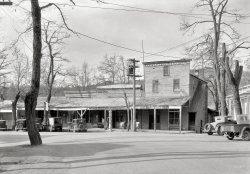
- Salvage for Victory: 1942
- ... before this was taken.
(The Gallery, Kodachromes, Cars, Trucks, Buses, Russell Lee, WW2) ... Posted by Dave - 11/17/2019 - 5:12pm -
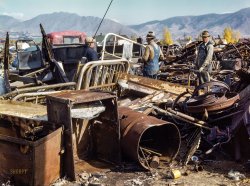
- Nothing Special: 1925
- ... other names besides Lee and Bankhead?
(The Gallery, Cars, Trucks, Buses, D.C., Natl Photo) ... Posted by Dave - 09/13/2011 - 7:39pm -
![Nothing Special: 1925 Circa 1925. "Dr. S.M. Johnson, Lee Highway Association." Seen here at the Zero Milestone in front of the White house. Samuel Johnson, "Apostle of Good Roads," was the tireless promoter of a southern-route transcontinental highway named after Gen. Robert E. Lee as a counterpart to the Lincoln Highway up north. National Photo Company Collection glass negative. View full size.
The Other EndThe Lee Highway terminated in downtown San Diego's Horton Plaza (the public square, not the shopping center). Here's a view of the Pacific Milestone, dedicated on November 17, 1923. San Diego's Col. Ed Fletcher is second from left, a vice president of the Lee Highway Association and a lifelong promoter of good highways.
His MonumentThe Zero Mile Stone was Samuel Johnson's "baby." In 1920, Congress authorized construction of the Lee Highway, but without funds. Johnson took charge of the project and raised money for its design and construction.
If this photo was taken at the dedication, the date would be June 4, 1923.
This site marked the departure point of the 1919 and 1920 Army Transcontinental Convoys across the United States. A young Dwight Eisenhower was on the first one.
Ah Take ExceptionSuh, What do you-all mean. "Nothing Special"? Suh, ah will have you-all to know that the sainted General Robert E. Lee was the flowah of Southern chivalry and the highest expression of the nobility of man. Those dam' yankees should have felt honahed to have the oppahtunity to ride on a road named foah him.
You carpetbagger you.
[The Zero marker is a special Nothing. Y'all get it now? - Dave]
Oh, mah goodness. Ah am so embarrassed. I hope you-all kin find it in yoah haht to fogive me.
[Bull City Boy wants to let leslie and Dave know that he is well familiar with "y'all" and uses that contraction often in informal correspondence. "You-all" was employed by way of a being a parody of a heavy Southern accent, as was the substitution of "ah" for "r".]
Youse GuysThank you, Dave, for knowing how to correctly spell y'all.
10-6 C 148A nice spot for a coffee break in the wee small hours of the morning.
Drive the Lee Highway!Now I know where the name Lee Highway originated. The 1918-vintage 15-ft concrete laid from Plaster City, California, across the mountains, to connect the farmlands of Imperial Valley to San Diego is still visible, and drivable, in a few segments off the equally charming 1930 vintage US 80, which parallels I-8 for 30-plus unmolested miles in San Diego County. Googling "Old US 80 CA" or similar phrases will take readers to several web sites devoted to the vintage concrete, including some photos of the hair-raising climb up the In-Ko-Pah Gorge.
Lee's HighwaysAnyone who's spent any time in Virginia will acknowledge the depth of the reverence and honor held for Robert E. Lee, the Old Dominion's first son. There are a number of roads called the Lee Highway there (Route 29 past Dulles Airport, one near Abingdon way down in the mountains, and, of course, Route 11 down the Shenandoah Valley -- the highway of my youth). Mentioning the "Civil War" will bring rebukes of correction: it was the "War of Northern Aggression."
Bankhead / LeeEnjoying the pictures and info. I am continuing to learn more about the auto trails. I do understand that in Texas, i.e. from Mineral Wells to Lamesa, they call it the Bankhead Highway. Moreover, doesn't it have other names besides Lee and Bankhead?
(The Gallery, Cars, Trucks, Buses, D.C., Natl Photo)](https://www.shorpy.com/files/images/31953u.thumbnail.jpg)
- But Seriously: 1940
- ... not the man. - Dave]
(The Gallery, Agriculture, Cars, Trucks, Buses, Russell Lee) ... Posted by Dave - 08/15/2018 - 9:52am -
![But Seriously: 1940 August 1940. "Farm Security Administration cooperative truck. Oneida County, Idaho." Medium format negative by Russell Lee for the FSA. View full size.
And no strapsto hold it all down. Nicely packed perhaps, but wouldn't want to be driving in back of that truck.
StackingI love the simple, elegant yet unassailable logic to his packing of the sacks. It's a thing of beauty.
Cerealsly ...I presume?
Happy ManA happy man with a good harvest and a good truck. I bet it felt good to have a bit of prosperity after the depression.
[The grain and the truck belong to the cooperative, not the man. - Dave]
(The Gallery, Agriculture, Cars, Trucks, Buses, Russell Lee)](https://www.shorpy.com/files/images/SHORPY-8b25801a.thumbnail.jpg)
- Tractor Pull: 1925
- ... obviously in 1st gear at about 2 mph.
(The Gallery, Cars, Trucks, Buses, Natl Photo) ... Posted by Dave - 09/27/2012 - 7:05pm -
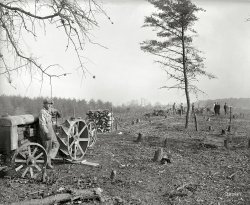
- Proceed With Caution: 1923
- ... cause the tires to shake & shimmy?
(The Gallery, Cars, Trucks, Buses, Chris Helin, San Francisco) ... Posted by Dave - 04/20/2016 - 10:52pm -
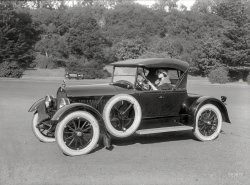
- Fifteenth and H: 1923
- ... structure at 1426 H. S. NW. ....
(The Gallery, Cars, Trucks, Buses, D.C., Natl Photo) ... Posted by Dave - 08/05/2012 - 10:56am -
![Fifteenth and H: 1923 The Woodward Building in Washington circa 1923. The former office building, put up in 1911, became apartments in 2005. National Photo Co. View full size.
I wonder......if people in the 1920's lived happier lives overall than people do today. Look at that picture. The streets seem clean and pleasant. I bet that area is a mess now.
[It's not. - Dave]
A win for preservationists Washington Post, Mar 9, 1990
Court Bars Demolition of Woodward Building
Preservationists Hail Curb on "Special Merit"
Preservationists hailed a major victory yesterday when the D.C. Court of Appeals stopped plans to tear down a turn-of-the-century office building in the Fifteenth Street Financial Historic District.
The decision, the first to use the city's historic preservation law to overturn a demolition order issued by the mayor, placed new limits on the city's power to find that the "special merit" of a development justifies destruction of a historic site.
"Virtually every historic building will now have to pass a tougher standard in order to be torn down. It will effect every single historic building," said Cornish F. Hitchcock, who represented the Committee of 100 of the Federal City, a private planning body that argued for yesterday's decision.
The stakes in the case were grander than its subject; The Woodward Building, a U-shaped beaux arts structure at 1426 H. S. NW. ....
(The Gallery, Cars, Trucks, Buses, D.C., Natl Photo)](https://www.shorpy.com/files/images/32261u.thumbnail.jpg)
- A Good Turn: 1936
- ... difference between 1982 and today! He began driving when cars were no more than veritable puddle-jumpers as compared to the sleek, ... plot which is online here .
(The Gallery, Cars, Trucks, Buses, D.C., Harris + Ewing) ... Posted by Dave - 08/18/2014 - 12:42pm -
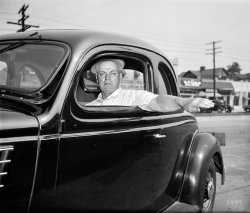
- Gun Moll: 1924
- ... springs. Most lady like indeed.
(The Gallery, Cars, Trucks, Buses, Chris Helin, San Francisco) ... Posted by Dave - 05/07/2015 - 9:35am -
![Gun Moll: 1924 San Francisco, 1924. "Lady greasing Oldsmobile sedan." A pioneer of Women's Lubrication. 5x7 glass negative by Christopher Helin. View full size.
High rankingIf license plate No. 3 warrants this beautiful damsel, imagine what the servicing ladies for 2 and 1 must have looked like.
She must have been a somebodyIs her licence place number 3? Wouldn't you have to be someone special to have such a low number?
[It reflects the numbering convention for California dealer plates at the time. -tterrace]
Zerk fittings (not yet)These are most likely Alemite fittings. The Zerk fitting was not patented until 1929 and is less vulnerable to dirt and allows greasing from an angle whereas the Alemite fitting required the connection be made straight on. As a tech in the bays, I don't see many grease fittings. Most all joints are sealed for life. Prior to the Alemite and Zerk fittings, oil and grease cups were used, and gravity was the method of delivery.
When I was starting out, my boss told me to go out and grease the universal joints on a fire truck that had pulled up. I crawled under the behemoth, and without thinking, attached the hose to the Zerk fitting, and opened my mouth for what reason I do not know. I hit the handle on the grease guy, and the clean grease went in, and the dirty grease shot out, back into the farthest reaches of my mouth, so far back my fingers could not get there. 40 years later, and I still remember the taste of that grimy u-joint grease.
Remember to extend the pinky finger.....when upon greasing the suspension springs. Most lady like indeed.
(The Gallery, Cars, Trucks, Buses, Chris Helin, San Francisco)](https://www.shorpy.com/files/images/SHORPY-331-01.thumbnail.jpg)
- Spheres of Influence: 1928
- ... must have been an expensive changeover.
(The Gallery, Cars, Trucks, Buses, D.C., Natl Photo) ... Posted by Dave - 04/13/2014 - 11:37am -
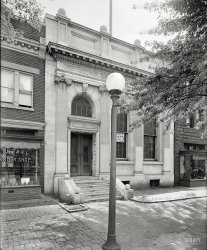
- Tween Angel: 1961
- ... 10 or 11 in this picture; he was always a small guy.
(Cars, Trucks, Buses, Kids, LOOK) ... Posted by Dave - 11/21/2017 - 10:05pm -
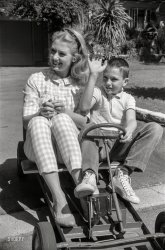
- Neoclassical Gas: 1919
- ... such as those by Biddle & Smart.
(The Gallery, Cars, Trucks, Buses, Chris Helin, Dogs) ... Posted by Dave - 02/09/2017 - 12:14pm -
![Neoclassical Gas: 1919 San Francisco, 1919. "Hudson Biddle & Smart touring limousine at Palace of Fine Arts." Home, Fido! 5x7 glass negative by Christopher Helin. View full size.
Not exactlyThe 1960s reconstruction of the Palace is MOSTLY an exact replica of the 1915 version. The wall of the Palace itself facing the colonnade was originally fully decorated with freestanding and engaged columns identical to those of the colonnade, and the central doors facing the entrance to the rotunda were elaborately framed. This wall was rebuilt smooth, dull and blank (presumably to reduce costs) and its bareness is now screened by trees; the central doors now have minimal moldings framing them. The original concept as executed made the crescent walk behind the colonnade a much richer, more enclosing, visual experience than it is today. A bit of the pergola which crowned the original wall is visible in this photo.
Theft insurance.Love the chain and padlock on the spare tire.
During the big warThe lad on the right has a navy pea coat with chief petty officer rating. Some kids even had a full uniform to wear. Last war that happened.
[He must be standing behind the car. -tterrace]
ReduxThat's the original Palace of Fine Arts Rotunda, built of wood and "staff" (a mixture of plaster and straw) for the Panama-Pacific International Exposition of 1915. Beloved by San Franciscans, it was the only structure retained afterward. The building deteriorated so badly over the next 50 years that it had to be demolished in the fall of 1964. An exact replica was built in its place from permanent materials and was completed two years later.
Early SUVwith integral roof rails and requisite pooch.
FashionistaShe can also be seen here.
Hudson Sold ValueWhen this car was new autos often had mechanical troubles that made them difficult to drive. Hudson was a medium priced car that was both powerful & reliable for its time.
The Super Sixes as shown in this picture were the first production car to feature a counterbalanced crankshaft allowing higher engine speeds, more power & longer life than was typical at the time.
Another feature was a cork clutch which ran in oil that was smooth, long lasting and did not slip. Other types of clutches often jerked, burnt out or slipped. Every Hudson except the first & last years of production was equipped with a cork clutch.
With these mechanical advantages and a moderate price, Hudson sold a lot of Super Sixes and some were fitted with elite bodies such as those by Biddle & Smart.
(The Gallery, Cars, Trucks, Buses, Chris Helin, Dogs)](https://www.shorpy.com/files/images/SHORPY-1086.thumbnail.jpg)
- Traffic These Days: 1917
- ... honor in front of the District Building.
(The Gallery, Cars, Trucks, Buses, D.C., Harris + Ewing) ... Posted by Dave - 05/06/2014 - 8:45am -
![Traffic These Days: 1917 Washington circa 1917. This is, as far as we know, our final glimpse of the Haynes roadster before it motors on its way down 14th Street into eternity. If the darn umbrella ever changes. Harris & Ewing glass negative. View full size.
Glass Plate/Negative difference?Is a glass plate a "positive" versus a glass "negative" of the photograph?
[They are the same thing -- the negative is a glass plate. "Plate" just means flat -- a flat sheet of glass, like windowpane. The negative is made by taking the glass plate out of the camera and dunking it in developing solution. Most of the images you see on Shorpy are made by shining a light through the negative onto an image sensor and then electronically reversing ("inverting") the result. Below are some pictures of an actual glass negative that I took in my kitchen. Click to enlarge. - Dave]
Glass on your plateJust saw a great documentary on the photographer Sally Mann. She was using a huge old field camera and shooting 8x10 inch glass plates, using a collodion wet plate process, with darkroom equipment in the back of her Suburban. She was shooting, amongst other things, old Civil War battlegrounds, and marveling at the flawlessness of old glass negatives from Brady and other Civil War era photographers. As we do here about twenty times a day...
It was great seeing how it's actually done.
I liked the notion of the Haynes roadster speeding off into Eternity, by the way. Very evocative.
Boss Shepherd and the District BuildingIt's nice to know that the statue of Alexander "Boss" Shepherd has been returned to its rightful place of honor in front of the District Building.
(The Gallery, Cars, Trucks, Buses, D.C., Harris + Ewing)](https://www.shorpy.com/files/images/01966a.thumbnail.jpg)
- Willard Batteries: 1947
- ... . Thanks to jschneid for the pointer.
(The Gallery, Cars, Trucks, Buses, San Francisco, Stores & Markets, W. Stanley) ... Posted by Dave - 05/05/2015 - 8:58pm -
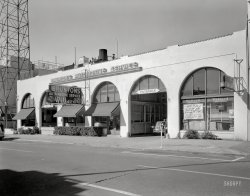
- The Squeaky Wheel: 1918
- ... Well someone had to say it.
(The Gallery, Agriculture, Cars, Trucks, Buses) ... Posted by Dave - 06/28/2016 - 11:16am -
![The Squeaky Wheel: 1918 Oakland, Calif., circa 1918. "Orchard tractor demonstration -- Fageol Motors Co. 'Walking Tractor'." Latest entry in the Shorpy Catalog of Agricultural Anachron­isms. 8x10 inch glass negative by Cheney Photo Advertising Co. View full size.
Not for lack of lubrication.I notice all the pictures of Fageol tractors you've posted show leaky seals on front hubs, it seems to have been a design feature. Tiller steering was an anachronism long before 1918 and must have been brutally hard work with those front wheels. Perhaps not surprising they disappeared only a few years later.
[According to the Research Department, there are no seals or bearings. Just a Flintstones-era spindle and disc, to which grease is liberally applied. - Dave]
OuchI have seen surviving steel wheels of this nature in person (sometimes one row, sometimes two, diagonal treads, or straight ones) but never anything like the rear wheel on this Fageol.
Looks like some kind of medieval torture device. Yikes.
Why I come back to ShorpyThis photo is a prime example of my love for Shorpy. I Google the interesting items and increase my knowledge.
1. Painting tree trunks was common when I grew up in 1940's Florida. Both citrus and regular trees were painted but I never knew why (citrus bark is very thin when young and susceptible to sun scald).
2, The teeth on the drive wheels are removable. Most likely to aid in manufacturing as I cannot see a way to break one off in actual use.
3, That sulky seat allows for a second worker to raise and lower the disk harrow blades. If it does not swivel, then the controls do not, as they say, "fall readily to hand."
Driving one of these contraptions... must have been a harrowing experience!
Insert Obligatory Hoyt Clagwell Comment hereWell someone had to say it.
(The Gallery, Agriculture, Cars, Trucks, Buses)](https://www.shorpy.com/files/images/SHORPY-995A.thumbnail.jpg)
- P.I.E.: 1940
- ... trailers since 1914.
(The Gallery, Arthur Rothstein, Cars, Trucks, Buses, Gas Stations) ... Posted by Dave - 01/28/2018 - 8:47am -
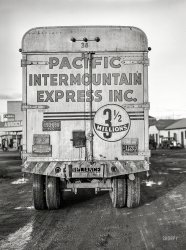
- Blair House: 1920
- ... The Fullerton model sold then, delivered in two railroad cars, for $2,243. They're going for $250K and above now, depending on condition ... Posted by Dave - 03/01/2013 - 4:14am -
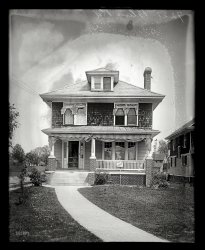
- Car Seat: 1918
- ... ID'd them on another Marmon here .
(The Gallery, Cars, Trucks, Buses, D.C., Kids, Natl Photo) ... Posted by Dave - 03/01/2017 - 12:11pm -
